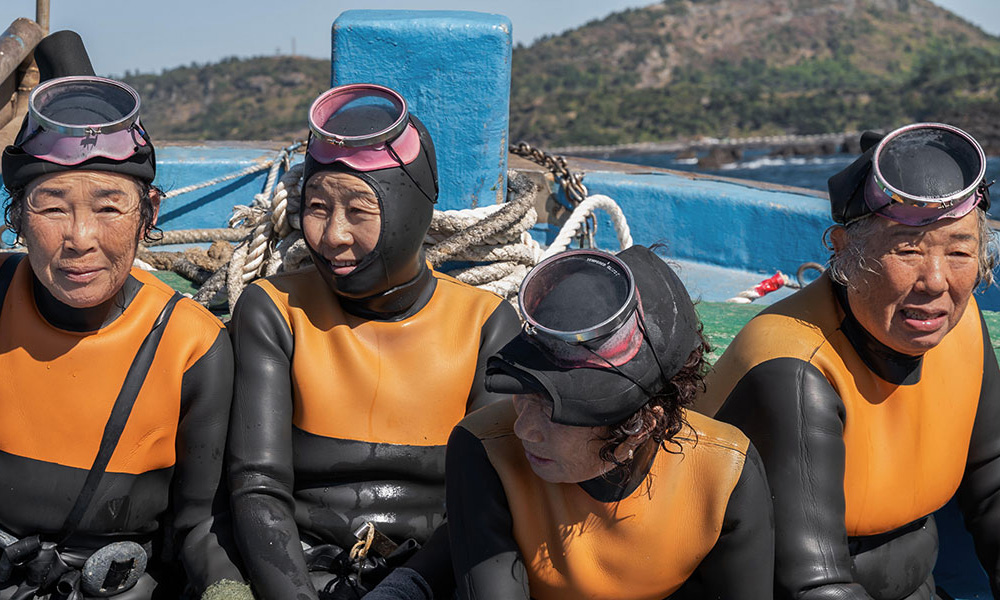“When I catch a lot of seafood, I don’t feel tired,” the 70-year-old In Sook Kim says in “The Last of the Sea Women,” still as spiky as the sea urchin she shucks along with other women her age who work in South Korea’s Jeju Island as Hanyeo, divers that collect seafood by hand. A job available to women when it was considered too taxing for most men, the profession has become a grand tradition in the country where by the 1960s, there were 30,000 active Hanyeo for a community of 200,000 in Jeju and those diving then are still jumping headfirst into the ocean on a regular basis, though fewer and fewer new to the practice are joining them. It might not have been Sue Kim’s dream exactly to join them – fortunately seeing out another in becoming a filmmaker – but from the time she was eight, she couldn’t help but revere the divers with their broad shoulders and unwavering determination when she’d see them along the shore during family vacations in Jeju and in returning as an adult, she unearths the kind of bounty of riches that the Hanyeo bring inland on a regular basis, observing a tradition kept alive against all odds.
“The Last of the Sea Women” captures the Hanyeo facing a particularly dire set of circumstances when it isn’t only the fact that the younger generation isn’t joining their ranks at the same level as they once did, but the occupation already filled with the dangers of being underwater for long periods of time – and most Hanyeo refuse to wear oxygen tanks when it would weigh them down – is threatened with becoming more perilous with the announcement that nearby Japan has plans to dispose of nuclear wastewater from Fukushima into the ocean, quite literally muddying the waters for fishing. The Hanyeo, who already have had front row seat to the effects of climate change when witnessing the erosion of the coral reef they’re around on a daily basis, aren’t just fighting to save their own jobs when banding together to protest the impending nuclear dump, but the community they’ve been nourishing for decades and Kim finds hope amidst their plight not only in their resistance to the harmful environmental actions taken by foreign governments, but a new wave of Hanyeo who have discovered it to be a rewarding way of life, with the director training her lens of Jeongmin and Sohee, two divers in their thirties, who have made the work cool again with TikTok videos.
Taking after its indefatigable subjects, “The Last of the Sea Women” may be set in a time of crisis, but it is never anything less than a rowdy and fun celebration of a group of feisty and fierce women who rise to the occasion, long knowing the power that lies underneath the surface. Following the film’s premiere at the Toronto Film Festival where it was the talk of the town, the film is being released onto AppleTV+ with a limited release in theaters this week and Kim spoke about how after waiting quite some time to tell this story, it was the right moment to shine a light on the Hanyeo, a generational divide that could make things tricky in terms of the actual production and reconsidering narratives around the elderly.
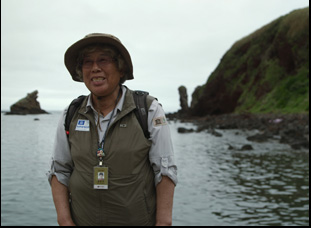
Yeah, I’ve been obsessed with the Hanyeo pretty much my whole life. They’ve just been these tough Korean anti-role models that I’ve always been drawn to and I really started going back to Korea as an adult to try and find them. But what really kicked this project into gear is a trip I was on down to Jeju about 10 years ago. I went with my mom and we were looking for a Hanyeo community. We saw this 84-year-old Hanyeo come out of the water, so of course we’re like, “Oh, let’s talk to her. She looks super interesting.” And I couldn’t help but ask her where all the younger Hanyeo were at because all of the women that I could see that were in the water with her all looked like grandmas. And she told me, “This is probably it. We are likely to be the last generation of Hanyeo because there are no younger women coming up after us.” I had been thinking about the Hanyeo my whole life, but suddenly the idea of this film took a turn towards, “Oh, now this is like an urgent mandate. I have to make this film because who knows how much longer we’re gonna have this generation? And what a shame it would be for the world to not be able to witness and see these women in action while we still have them and while they could tell their own story.” That’s really when this film became a real urgent project that I had to get made.
How much history was there to actually draw on? You have some great archival in the film, but you do get the sense you’re one of the first to document it.
All of the archival material that we pulled into the film was taken from this one incredible film that was made in the ’60s, like a 50-minute [news] segment that someone had made. They actually did a wonderful job and they had an underwater camera, and I don’t know how they figured out how to do that back then, but it came from this one video which I think is so wonderfully shot. There were actually quite a lot of archival materials that we originally had pulled into the film, but it was very, very hard to license it. They all belong to Korean news organizations that wouldn’t really allow us to license them, but there’s not a ton of documentation about the Hanyeo from that era, unfortunately. I don’t know if that’s just because the technology wasn’t there in Korea at the time — back in the ‘60s, [they] were still recovering from the Korean War and it’s a very impoverished country, so there’s a void of really good archival photos and video of the Hanyeo, unfortunately.
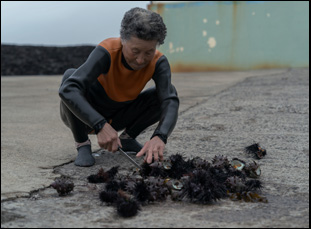
Yeah, it is very, very difficult to get into contact with our Hanyeo subjects. Some of them have phones, but a lot of them don’t, and none of them seem to have computers, so there’s no such thing as email. And then even the ones that do have phones use them mostly to keep in contact with people. They don’t use them in the way that we use phones organizationally [with] our calendars, our reminders, our health news, so when we would try to schedule shoots with them, their relationship with time and schedules is very different. We would have to send members from our team in Korea down to the Hanyeo communities usually about a week before we were going to film with them, just to remind them that we had made plans to film with them. Every time we did that, we didn’t always know for sure when we showed up to film with them, if they’d be there, because there’s just no system of them keeping a calendar for their shoots. Our joke was every time we asked them if we could film with them in the next month, say we’re there for June, we’d be like, “Hey, is it okay if we film you in July for sea urchin catching season?” The stereotypical answer was always, “We’ll see.” There was no “yes,” or setting of dates. It was just a, “We’ll see.” So it was always a little bit of a gamble of if they would actually be there when we were ready to shoot.
Did you know what you were walking into as far as the story was concerned? It really is a moment of crisis with the Fukushima waste water situation.
I had actually started pitching this project quite some time ago, maybe six-ish years ago and it was a little bit of a different story then. I wanted to tell the story of the Hanyeo in the same way we ultimately did, but I didn’t know about the environmental factors that were a part of the existential threats to the Hanyeo culture. I thought it was really just a matter of younger women that weren’t interested in the profession, so that was the central thesis of the film I was pitching, and I say with all sincerity now, luckily no one was interested in the film at the time.
At first, I was very frustrated with that because of course I really wanted to make this film, but I actually think that worked out in our benefit because by the time I partnered with Malala [Yousafzai] and [her production company] Extracurricular, that really is what started opening all the doors with A24 and Apple, and Japan’s government had already announced that they were going to release the radioactive treated wastewater from Fukushima, so it created a more urgent and visible conflict. Those years of pitching when I couldn’t get funding, as frustrating as it was, I think was meant to be because we were able to show a more urgent, pressing conservationist story in our film because of the timing. We did know that that was probably going to affect our Hanyeos because of course that water is being released into the ocean that they share.
What I didn’t know is there’s many parts of the story, just like real life, that just happen and you just have to follow it. I didn’t know that one of our main subjects would break her foot and that would be such a big part of the film because of how fragile and vulnerable our Hanyeos actually are and how there’s so little support for them structurally and socially. It [could] help advocate for maybe some more federal funding or some social support for this community. I also didn’t know how the Hanyeos would actually react to the Fukushima water release issue. I knew that it would affect them, but I had no idea that they would become so motivated and galvanized to become activists against it and to start speaking up. I absolutely did not know that Jang Soon-duk would be invited to speak at the U.N. That happened organically because of how outspoken they were at the protests, so all of that unfolded before our eyes and that’s part of the wonderful process of making documentaries. A lot of the time you really don’t know what’s going to happen, but life ends up being more interesting and complicated than you could even have planned.
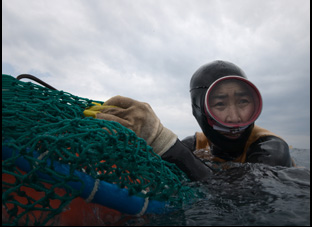
I do really like to let the subjects dictate the tone and going into filming this, I did want to celebrate the strength and the empowerment and the physical agility of these women. Because I’d visited Jeju and filmed them multiple times, I knew that these are very bold, vibrant, confident, fearless women, so I knew that the tone would be less solemn and a little bit more vibrant, but at the same time, there are things that I just couldn’t have anticipated. I could not have anticipated that they fight [amongst each other] as much as they do. When that was happening, where every time we film with them, someone’s beefing, but then there’s always huge amounts of laughter, I really let their temperaments and their personalities set the tone.
But I did want to show them in a heroic manner because that’s who they have been for me and that’s also how they see themselves. When we were casting, part of my questions to them were, “How do you feel like you’ve been represented in the media?” and “How truthful do you think that is to who you are?” They often told me that other media representations of the Hanyeo culture tended to have this “sad grandma” narrative, like, “Look how sad it is that this 84-year-old woman has to work so hard every day.” And they hate that. They’re like, “We are not sad grandmas. We are warriors of the ocean.” They’re deeply proud of the work that they do and they take great joy and fulfillment from working in the ocean, so from those conversations, I promised them that I would give them their agency and their power back and we would not promote the sad grandma narrative.
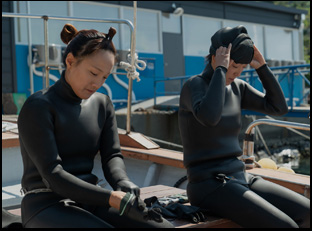
It’s been amazing. I am seeing in person how people are falling in love with the Hanyeo and that’s really all I wanted. I wanted global awareness of this incredible community of women. In Korea, most people know who the Hanyeo are, but outside of Korea, it was really very hit or miss, so part of my objective with this film was to document this culture before it’s gone, but also for the world to see how strong and cool and aspirational this group of elderly women were and how heroic elderly women could be, especially this community. We’ve been lucky enough to have our Hanyeo at each of these festivals and seeing them witness that they are being recognized by Western audiences across the world that they never imagined that they’d ever see has been so gratifying. I feel like every screening I’ve sobbed because that admiration for Hanyeo is happening and it’s deeply emotional for me.
“The Last of the Sea Women” is now streaming on AppleTV+. It also opens theatrically in Los Angeles on October 11th at the Laemmle NoHo 7 and in New York at the Village East.




